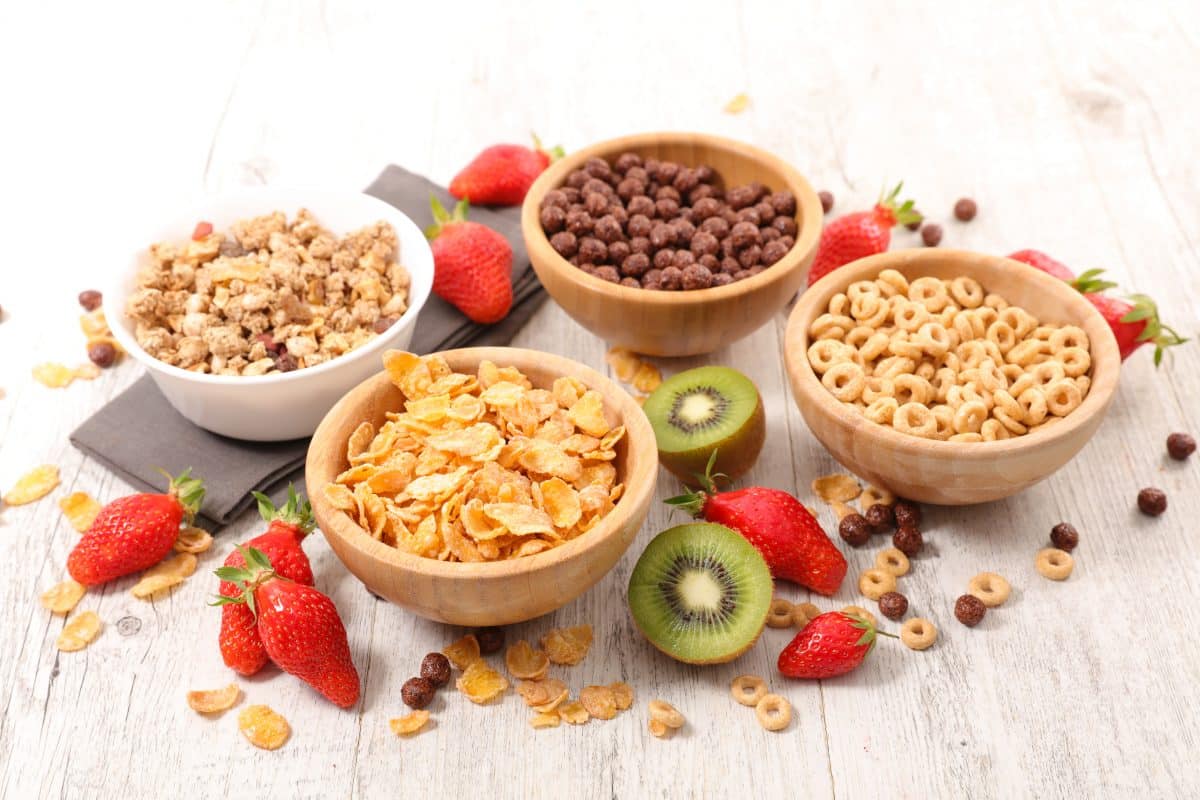Dietitian approved low FODMAP cereal list
- Low FODMAP diet
Are you wondering which low FODMAP cereals you can eat first thing in the morning? Being on a low FODMAP diet doesn’t mean that you can’t enjoy breakfast cereals anymore.
In this article, we will explore the health benefits of cereal and share some certified low FODMAP cereals. We will also include some other low FODMAP breakfast ideas to inspire you for your breakfast.

Do breakfast cereals contain FODMAPs?
Many breakfast cereals contain FODMAPs. This is because breakfast cereals commonly contain the following ingredients (1):
- Wheat
- Spelt
- Rye
- Honey
- High FODMAP dried fruits
The main FODMAP found in the above breakfast cereals is fructans.
Fructans are poorly broken down in the small bowel, leading to osmosis and fermentation in the gut. In IBS, this can cause symptoms such as diarrhea, bloating, and flatulence (2).
High FODMAP added ingredients in breakfast cereals
Breakfast cereals may have added high FODMAP ingredients for flavor. Cereals are sweetened with the following high FODMAP ingredients:
- Fructose or high fructose corn syrup
- Artificial sweeteners such as sorbitol and mannitol
- Chicory root or inulin
How to Choose Low FODMAP Breakfast Cereals
Cereals that are based on the following ingredients are more likely to be low FODMAP:
- Buckwheat, such as buckwheat flakes
- Corn, such as cornflakes
- Rice-based cereals such as Rice Krispies
- Millet, such as millet flakes
- Amaranth, such as puffed amaranth cereal
- Oats, such as porridge (3)
However, check the food labels for any additional high FODMAP ingredients we previously listed.
You should also check the portion sizes of some cereals using the Monash app. In larger potions, some cereals may become high in FODMAPS. Some examples include:
- Cheerios (low in FODMAP in a portion of 1/2 cup)
- Kellogg’s classic corn flakes (low in a portion of 1 cup (28g)
Choosing Free-From Breakfast Cereals
It can be helpful to check the free-from section when choosing a low FODMAP cereal. This is because gluten-free products have had wheat, barley, and rye removed, which are a source of fructans.
For example, Weetabix cereals are made from wheat and so, are also high in fructans, making them a high FODMAP breakfast cereal.
However, Gluten Free Weet-Bix is low FODMAP as it is low in fructans (4).
Milk-free products are also lactose-free and, therefore, more likely to be low FODMAP. But again, always check the labels for other ingredients!
FODMAP-Friendly Breakfast Cereals Available to Purchase
Using the above tips will help you pick a low-FODMAP cereal. However, to get you started, we have linked some low FODMAP cereals for you below.
Low FODMAP Cereal List;
- Carman’s Super Berry Muesli
- Carman’s Crispy Deluxe Almond and Maple Gluten Free Muesli
- Classic Active Balance Almond & Cashew Multigrain Flakes
- Classic Active Balance Cranberry & BuckwheatKellogg’s Rice Krispies
- Kellogg’s Corn Flakes
- Kellogg’s Frosted Krispies
Low FODMAP Alternatives to Milk and Yoghurt for Breakfast
Milk and yoghurt are commonly used high FODMAP ingredients added to breakfast cereals. This is because cow’s milk is high in lactose. Therefore, buying lactose-free cow’s milk is a good alternative
Alternatively, you can try low FODMAP plant-based milk with the help from our post ‘Does low FODMAP milk exist?‘.
Health Benefits of Cereals
Breakfast cereals can form part of a healthy balanced diet (6). They can improve satiety and prevent overconsumption of food later in the day (7).
Wholegrain cereals are a great source of (8, 9):
- Fibre
- Essential vitamins and minerals, such as B vitamins and iron
- Antioxidants
- Phytonutrients
How to Increase the Fibre Content of Low FODMAP Breakfast Cereals
Breakfast is an excellent opportunity to kick-start your fibre intake for the day. And ensuring you have an adequate intake of fibre during the low FODMAP diet is important for preventing constipation.
To increase the fibre content of your breakfast, try adding low-FODMAP fruits such as blueberries or strawberries (portion check required).
Additionally, you can try adding a tablespoon of linseeds/flaxseeds or psyllium husk to your breakfast cereals.
It is important to remember to keep your fluid intake up to 1.5-2L per day, particularly when increasing your fibre intake.
What else can I eat for breakfast with IBS?
If cereals aren’t your go-to breakfast, or you are looking for more low-FODMAP breakfast ideas, there are plenty of other options.
You can still enjoy a variety of breakfasts such as pancakes, sausages, and smoothies whilst on the low FODMAP diet.
You just need to be aware of common high FODMAP ingredients and, if needed, use suitable low FODMAP alternatives.
Check out our post on 35 low FODMAP breakfasts for ideas.
Summary
Many low FODMAP cereals can be enjoyed if you have IBS or are following the low FODMAP diet.
Choose cereals that are buckwheat, rice, corn, oats, amaranth or millet based and remember to check food labels for any additional high FODMAP ingredients.
You can try the low FODMAP cereals we have listed in the article and check the Monash app for more examples and portion sizes. Also, check the FODMAP content of any cereal toppers and milk you use.
Article written by Anastasija Gorbatenko and reviewed by Beth Willson Specialist Gastroenterology Dietitian BSc Hons and Kirsten Jackson Consultant Dietitian BSc Hons, RD, PG Cert